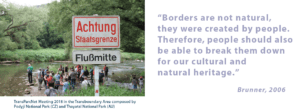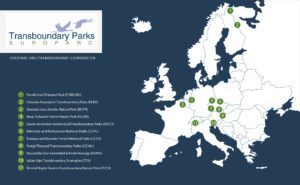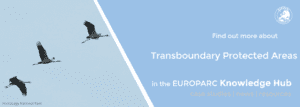The Berlin Wall fell on the 9th November 1989. On the 30th anniversary, the European Transboundary Parks published a declaration highlighting the need to cooperate across frontiers.
Nature has no Borders
The EUROPARC network thrives on connecting Protected Areas that, despite their proximity, remain divided by virtual administrative, political, and cultural barriers—even in an increasingly unified Europe.
Since its inception, EUROPARC’s Transboundary Parks Programme has embodied the spirit of the Berlin Wall’s fall. It reflects our daily commitment to managing shared biodiversity, transcending political boundaries.
Our history, knowledge, and values have inspired us to foster a movement of active individuals, collaboratively creating projects that dismantle barriers through the EUROPARC Transboundary Parks Programme—a truly European endeavour.
The inspiration from the Berlin Wall’s fall is particularly evident, as many of our protected areas lie along the former Iron Curtain, now the European Green Belt. A glance at a map of Europe vividly illustrates this point.
Equally clear is the passion and dedication of those involved in the Transboundary Programme. They are driven by the joy of working together in territories that were once long divided

Commitment for peace, dialogue and nature protection
For these reasons and on this occasion, we firmly declare our commitment to peace, dialogue, and nature protection. We pledge our support, within the framework of our institutional goals and expertise, to any initiative aimed at fostering cooperation between European states, both within and beyond the European Union.

Award Ceremony at EUROPARC Conference 2019 – Veglia Devero Nature Park becomes a certified Transboundary Area.
Europe is a complex continent with millennia of human interaction woven into the fabric of the natural world. The most visible manifestations of this history are the many political borders that abound and indeed change over time.
Nature, however, never recognises these artefacts of human civilisation. Our Protected Areas represent the most special aspects of our small, marvellous, and populated continent, constituting a “shared European inheritance” of nature protection.
Yet in places, borders create artificial barriers to the management of these precious natural resources. Where Protected Areas share a common political boundary, these management issues come into sharp focus and require special consideration.
The EUROPARC Transboundary Programme seeks to support a process of mutual understanding, often between countries where history has sown distrust or administrative barriers. It aims to develop management tools that enable greater cooperative management.
The Protected Areas awarded the EUROPARC Transboundary Programme Certificate form the TransParcNet, an innovative platform for safeguarding cross-border biodiversity, ecosystem services, and cultural landscapes. It also inspires and encourages people to better understand the importance of transboundary cooperation.
Certified Transboundary Areas
Since the Basic Standards evaluation system was launched in 2003, 29 European Protected Areas have been successfully certified as 13 Transboundary Parks under the EUROPARC programme “Transboundary Parks – Following Nature’s Design”.
The below map highlights only those Transboundary Parks that have been certified through the EUROPARC verification process. Numerous other cross-border areas exist throughout Europe that have not received certification. Should you wish to learn more about the certified Protected Areas, please visit this page.

Your memories of the fall of Berlin Wall
We would also like to invite you and your networks to share your own memories of the fall of the Berlin Wall, by uploading a testimonial on the “My House of European History” platform. My House of European History aims to be a virtual library of testimonials and stories from people across Europe, and many nice uploads of people sharing their memories of the fall of the wall already feature.
